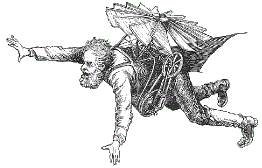| Gothic Steam Phantastic > Information > Sleepy Hollow |
 Sleepy Hollow |
 |
| -*- Home -*- Daleth-*- I&I RPG -*- Information -*- Forum -*- Credits -*- Links -*- |
|
Sleepy Hollow byTim Burton, 1999 The legend of Sleepy Hollow (by Washington Irving) is well known in the USA. I don't know the legend too well, but it was not a set back to enjoying the movie by Tim Burton. It's about a headless horseman... a bit of a Halloween movie... 'nuff said. Setting The movie is set in 1799, nearly 19th century. The costumes are very nice, too nice at times because they appear to be very clean when not stained with blood. The place Sleepy Hollow is a creepy place, suffocating in mist and autumn leaves, which is all right for a horror movie. There is a nice chase in a carriage through the wood, a bit of action that brings on memories of From Hell, Vidocq and arrr, Mad Max. The screen is rather dull. They have chosen to leave out bright colours and shoot the movie in shades that remind of the old silent black-and-white movies. I was not very pleased with that; real black and white is better, more powerful with it's possibilities for contrast, and Vidocq showed that you can make a creepy historic movie in flashing bright colours. The setting reminded me of E.A. Poe's "Landor's Cottage" - a rural part of the United States, far away from the city, where nature is almost unspoiled, but where suspense seems to lurk behind every tree. Sleepy Hollow is not a steampunk or even gothic movie as such. What was really interesting to see in the movie is the technics versus the myths. Technics vs. magic Ichabod Crane (played by Johnny Depp) is a modern man, a constable from New York who uses self-invented devices to trace down murderers. Or that is what he wants to do. He only has his technics, including some chemicals and optic devices (I would have loved some more of these crazy devices in the movie), and his logic to solve the riddle of the headless horseman. Where others before him in the rich history of cinema do conquer evil by using such devices (I only mention James Bond with the gadgets from Q's department), Crane fails to do so. He indeed uses these devices, this high-tech from the end of the 18th century, but they are no real help for him. Instead, the movie turns to the old believes in magic, and Crane can't fight the magic with his modern thinking and technology. Magic is what rules the story. This is an interesting thought, that really belongs in the 18th century, given the popular believe that in the 19th century people thought technic would always win, and they could conquer the world with it - and it could even rule the world without the aid of humans in the pulp fiction with all the robots and proto-computers in them. The very combination, or rather the contrast, of technics from the city applied into a superstitious rural society might fit well in many steampunk stories, and make it extra snappy, even if you leave out the real working witch-magic from Sleepy Hollow. Windmill I could not set the (beautifully designed) windmill in the story. I don't know if it had a deeper meaning to it, apart from a reference to Frankenstein. After all, a mill spelled technics in earlier days, and because technics where not understood by the large majority, technics spelled magic and thus evil. So if the scenes in the windmill meant something, the witch being there for no clear reason at all anyway, what did the destruction of the windmill mean? Was that the very point where magic was defeated? If so, it was in a rather crude, primitive way that does not fit the character of Crane. Optical tricks A nice touch was the magic lantern in the story. It's this little lamp with two candles in it, and a turning metal outside with cut-out figures in it. The heat from the candles makes the outside turn, and the candlelight shines through the figures to project them on the wall. Easy, realy, but well worth building in real life and get it into a steampunk surrounding. There were more optical tricks in the movie: the child's game with the bird in the cage belonging to Crane (a piece of paper with a bird drawn on one side, the cage on the other - spin it fast enough and you will see the bird in the cage. According to the Internet Movie Database the device is called a Thaumatrope and was invented in 1825) and the fake headless horseman, created by the villagers of Sleepy Hollow. © Yaghish 2003 |
| Links |
|
The movie on the Internet Movie Database: www.imdb.com/Title?0162661 The official site looks like closed down. |
| -*-© Steammasters 2003-*- |
| ^ Up |